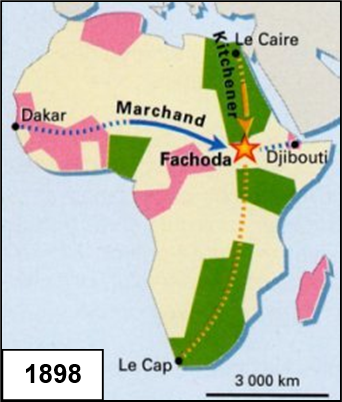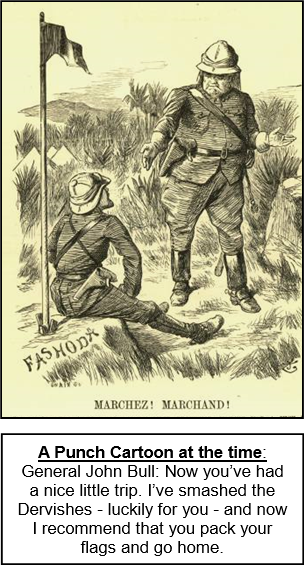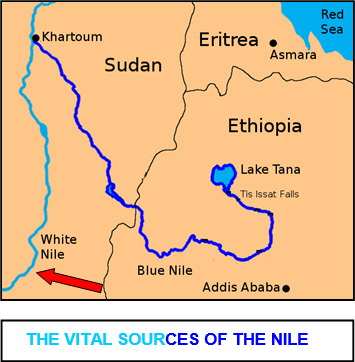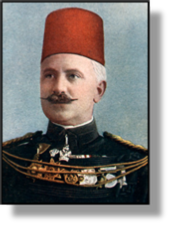xxxxxAs we have
seen, in 1882 the
British, the masters of Egypt, decided to withdraw the Egyptian
troops from the Sudan, then in a state of rebellion. There
followed the siege of Khartoum and the killing of General Gordon
and his garrison. In the late 1890s, however, fearing that other
colonial powers, particularly the French, might seize the
headwaters of the Nile - vital to Egypt’s survival - the
British decided to re-conquer the Sudan. This was achieved by
General Kitchener at the Battle of Omdurman in September 1898, but by then the French
had put into operation a plan to unite their African colonies from
west to east, thereby stopping the British from achieving a
similar project north to south. Furthermore, with the support of
the Ethiopians they planned to invade the Sudan and threaten Egypt
by gaining control of the upper waters of the Nile. In July 1898 a small French force,
led by Captain Marchand, crossed Africa from Senegal and, reaching
Fashoda in the Sudan, claimed the area around the White Nile as a
French protectorate. Kitchener, fresh from his victory at
Omdurman, assembled a sizeable force and, travelling by boat,
reached Fashoda in the September, but Marchand refused to vacate
the area, and there followed a diplomatic row between France and
Britain which almost led to a full-scale war. Eventually,
however, the French realised that they were at a military
disadvantage, and their troops were withdrawn. The “Fashoda
Incident” caused ill-feeling between the two countries, but
the fact that the crisis was solved diplomatically proved a
turning point in Anglo-French relations, and, because of the
growing might of Germany, it actually led to the Entente
Cordiale of 1904.
xxxxxAs
we have seen, after the British took over control of Egypt in 1882, following the Battle of
Tel el Kebir, the British government decided that the Egyptian
garrisons in the Sudan should be withdrawn. It was considered that
this vast country to the south of Egypt, then in the throes of a
rebellion by a religious fanatic, would be too expensive to pacify
and too difficult to administer. It was during this withdrawal that
Khartoum, the capital, was besieged by the Mahdists and General
Charles Gordon and his garrison of 7,000 men were slaughtered when
the city was finally entered in January 1885.
xxxxxTowards
the end of the century, however, the British were forced to change
this decision. Other European nations - such as Belgium, Italy
and France - were beginning to see the Sudan - not yet
colonized - as an area for occupation and exploitation. This
alarmed the British government. If the Sudan were invaded and
occupied, then the headwaters of the Nile, so vital to the political
and economic stability of Egypt, would be in the hands of - and
under the control of - a foreign power. It was for this reason
that in March 1896 a large army commanded by General Herbert
Kitchener was ordered to invade and re-conquer the Sudan. It
was not until September 1898, however, that the victory at the Battle of Omdurman virtually secured the
country for the British and by then it was too late. A French
contingent had already arrived at Fashoda on the White Nile and
claimed the area as a French protectorate.

xxxxxFor
some years the French had shown an interest in the African coastline
along the Red Sea following French exploration of the area in the
mid-19th century. In the 1880s they entered into trade
agreements with a succession of Somali Sultans and, as a result,
were granted a protectorate (French Somaliland) over the area known
as Djibouti on the Gulf of Tadjoura. Then in 1896 their interest in the region was further heightened.
In that year, as we have seen, they gave advice and war equipment to
the Ethiopians, and this helped them to defeat an Italian invasion
at the Battle of Adowa. In recognition of their assistance, their
neighbours allowed them to use Ethiopia as a staging ground for
incursions into southern Sudan. It was at this point that the French
conceived the idea of laying on a military expedition that would
march from West Africa - where they already had sizeable
possessions - to Fashoda in southern Sudan, an ideal location
for the building of a dam to
divert - and thereby reduce - the upper waters of the
White Nile. Such a project, they anticipated, would link French
possessions across Africa from west to east (from the Niger to the
Nile); prevent the British from joining up their territories from
north to south (Cairo to Cape Town) - the life-long dream,
as we have seen, of the British diamond magnate Cecil Rhodes -
and possibly, by impeding the flow of the Nile, force the British
out of Egypt. Thus the small settlement of Fashoda, by being at the
point where the colonial ambitions of Britain and France crossed and
clashed (see map), was set to become the centre of a major
international crisis.
 xxxxxThexNile
Expedition, led by Captain Jean-Baptiste
Marchand (illustrated),
and made up of seven French officers and
120 Senegalese infantry, set out from Dakar on its ambitious and
arduous mission in June 1897. It travelled up the Congo as far as
Bangui, and then after a mammoth 14 month trek by foot and boat
across the heart of Africa - much of the territory
unchartered - the small contingent reached Fashoda in July 1898. There it raised the French flag and
set about repairing the town’s dilapidated fort. According to a
pre-arranged plan, it was due to meet up with two expeditions
coming from the east, across Ethiopia, but neither turned up.
Instead, in September Marchand was faced with the arrival of a
sizeable Anglo-Egyptian force aboard five steamers. Having
learnt from one of the Mahdist prisoners that a small French
contingent had arrived at Fashoda, General Kitchener had quickly
assembled a powerful flotilla and set off to put into effect what
the re-conquest of the Sudan had all been about - the
safeguarding of the upper waters of the Nile. But Marchand
politely told the British commander that he was staying put.
Kitchener, showing a great deal of restraint (especially since he
had overwhelming superiority in manpower and firepower), raised
the Union Jack alongside the Tricolour, set up camp, and left the
politicians to sort it out.
xxxxxThexNile
Expedition, led by Captain Jean-Baptiste
Marchand (illustrated),
and made up of seven French officers and
120 Senegalese infantry, set out from Dakar on its ambitious and
arduous mission in June 1897. It travelled up the Congo as far as
Bangui, and then after a mammoth 14 month trek by foot and boat
across the heart of Africa - much of the territory
unchartered - the small contingent reached Fashoda in July 1898. There it raised the French flag and
set about repairing the town’s dilapidated fort. According to a
pre-arranged plan, it was due to meet up with two expeditions
coming from the east, across Ethiopia, but neither turned up.
Instead, in September Marchand was faced with the arrival of a
sizeable Anglo-Egyptian force aboard five steamers. Having
learnt from one of the Mahdist prisoners that a small French
contingent had arrived at Fashoda, General Kitchener had quickly
assembled a powerful flotilla and set off to put into effect what
the re-conquest of the Sudan had all been about - the
safeguarding of the upper waters of the Nile. But Marchand
politely told the British commander that he was staying put.
Kitchener, showing a great deal of restraint (especially since he
had overwhelming superiority in manpower and firepower), raised
the Union Jack alongside the Tricolour, set up camp, and left the
politicians to sort it out.

xxxxxThe
military confrontation at Fashoda led to several weeks of intense
negotiation between London and Paris, and public outrage in both
countries reached to fever pitch. In October both nations began to
mobilize their navies in preparation for war. The British claimed
that the Sudan was an Egyptian protectorate and that, by their
victory over the Sudanese at the Battle of Omdurman, they had re-conquered
the country for the Khedive. The French argued that they had every
right to possess the Upper Nile region because the British had
failed to achieve an “effective occupation”, a requirement laid down
by the Berlin Conference of 1884. What eventually brought about a settlement, however,
was the practical realisation on the part of the French that they
were not in a position to win in the dispute. Their army was far
larger than that of the British, but it would have to be
transported, and this would be a hazardous operation given the
strength of the British navy. Furthermore, at ground zero - the
area under dispute - the small French force would quickly be
overwhelmed. And there was, too, a wider consideration. France was
growing ever more concerned about the growing might of her land
neighbour Germany. This was not the time to involve the country in a
colonial war about a remote corner somewhere in Africa. On the 3rd
November the French government ordered Major Marchand (promoted soon
after arriving at Fashoda) to withdraw from the Sudan and return to
France via Djibouti. He was much aggrieved at the decision, but he
was obliged to obey.
 xxxxxThe settlement of the
Fashoda crisis put an end to what came to be called “the race for
the Nile”. There were three losers. Firstly, the French failed in
their bid to establish a continuous band of colonies across Africa -
aided and abetted by Ethiopia, their friend of convenience -, a
move that would have enhanced their own position in Africa and, at
the same time, curbed the power of Britain, their colonial rival.
Secondly, there were the Russians, who as allies of the French, had
themselves been drawn into the affairs of Ethiopia. They were never
to realise their dream of gaining a foothold in Africa at the mouth
of the Red Sea as a counterweight to Britain’s control of Egypt and
the Suez Canal, and as a possible launching pad for a colonial
future in Africa. And thirdly, there were the Ethiopians. Fresh from
their great victory over the Italians at the Battle of
Adowa, they embarked on territorial
expansion in 1897 and by July had reached the White Nile and raised
the Ethiopian flag alongside that of the French – their position arrowed on map above. But the
capitulation of the French over Fashoda put an end to such grand
ideas. In March 1902 the Ethiopian leader, Menelik II, was obliged
to sign a treaty with Great Britain in which he renounced any claims
to the east bank of the Nile, and pledged not to redirect any waters
of the Nile’s tributaries without British permission. The sources of
the Nile which, in the words of the young Winston Churchill, “are as
much an integral part of Egypt as the roots are an integral part of
a tree”, were firmly under British control.
xxxxxThe settlement of the
Fashoda crisis put an end to what came to be called “the race for
the Nile”. There were three losers. Firstly, the French failed in
their bid to establish a continuous band of colonies across Africa -
aided and abetted by Ethiopia, their friend of convenience -, a
move that would have enhanced their own position in Africa and, at
the same time, curbed the power of Britain, their colonial rival.
Secondly, there were the Russians, who as allies of the French, had
themselves been drawn into the affairs of Ethiopia. They were never
to realise their dream of gaining a foothold in Africa at the mouth
of the Red Sea as a counterweight to Britain’s control of Egypt and
the Suez Canal, and as a possible launching pad for a colonial
future in Africa. And thirdly, there were the Ethiopians. Fresh from
their great victory over the Italians at the Battle of
Adowa, they embarked on territorial
expansion in 1897 and by July had reached the White Nile and raised
the Ethiopian flag alongside that of the French – their position arrowed on map above. But the
capitulation of the French over Fashoda put an end to such grand
ideas. In March 1902 the Ethiopian leader, Menelik II, was obliged
to sign a treaty with Great Britain in which he renounced any claims
to the east bank of the Nile, and pledged not to redirect any waters
of the Nile’s tributaries without British permission. The sources of
the Nile which, in the words of the young Winston Churchill, “are as
much an integral part of Egypt as the roots are an integral part of
a tree”, were firmly under British control.
xxxxxThe
ill-feeling between the Britain and France took some time to
die down. Indeed, the French were decidedly anti-British during
the Second Anglo-Boer War that began the following year.
However, a settlement of the Fashoda dispute in March 1899 by which
the French were allowed to expand eastward up to (but not including)
the Nile watershed, somewhat took the sting out of the dispute.
Furthermore, the fact that the two armies at Fashoda had not fought
each other on the spot, and that  the
matter had been eventually resolved by diplomatic means was a
turning point in Anglo-French relations. Given the changing
balance of power on the European continent, it paved the way for a
rapprochement between the two nations, the Entente
Cordiale of 1904. This eventually developed into a military
alliance against Germany in the First World War.
the
matter had been eventually resolved by diplomatic means was a
turning point in Anglo-French relations. Given the changing
balance of power on the European continent, it paved the way for a
rapprochement between the two nations, the Entente
Cordiale of 1904. This eventually developed into a military
alliance against Germany in the First World War.
 xxxxxIn the Sudan, there was much to be done. Following the
final defeat of the Mahdist forces at the Battle of Umm Diwaykarat
in November 1899, work was begun on the administration of the
country. An Anglo-Egyptian Condominium was set up by which
sovereignty was jointly shared by the Khedive and
the British crown, though, in reality, the control of the country
was largely in the hands of the British. The executive power was
invested in a governor-general, nominated by the British
government, and his first task was to restore order throughout the
country. The northern region of the Sudan was pacified within a
short time, and steps were taken to modernise the administration,
but in the south the keeping of the peace proved the major task.
LordxKitchener served
as the first governor-general, but he was soon succeeded by General Sir Francis Reginald
Wingate (1861-1953)
(illustrated),
a man who knew the Sudan well and, like Lord
Cromer (1841-1917) in Egypt,
introduced reforms, encouraged development, and greatly improved the
lives of the ordinary people.
xxxxxIn the Sudan, there was much to be done. Following the
final defeat of the Mahdist forces at the Battle of Umm Diwaykarat
in November 1899, work was begun on the administration of the
country. An Anglo-Egyptian Condominium was set up by which
sovereignty was jointly shared by the Khedive and
the British crown, though, in reality, the control of the country
was largely in the hands of the British. The executive power was
invested in a governor-general, nominated by the British
government, and his first task was to restore order throughout the
country. The northern region of the Sudan was pacified within a
short time, and steps were taken to modernise the administration,
but in the south the keeping of the peace proved the major task.
LordxKitchener served
as the first governor-general, but he was soon succeeded by General Sir Francis Reginald
Wingate (1861-1953)
(illustrated),
a man who knew the Sudan well and, like Lord
Cromer (1841-1917) in Egypt,
introduced reforms, encouraged development, and greatly improved the
lives of the ordinary people.
xxxxxIncidentally, earlier in his career Major Jean-Baptiste
Marchand (1863-1934) had taken part in the French conquest of
Senegal, and in 1889 had been severely wounded during the capture of
Diena in Mali. He later fought with the French expedition to China
during the Boxer Rebellion of 1900, and was promoted to the rank of general during the
First World War.




 xxxxxThexNile
Expedition, led by Captain Jean-
xxxxxThexNile
Expedition, led by Captain Jean-
 xxxxxThe settlement of the
Fashoda crisis put an end to what came to be called “the race for
the Nile”. There were three losers. Firstly, the French failed in
their bid to establish a continuous band of colonies across Africa -
xxxxxThe settlement of the
Fashoda crisis put an end to what came to be called “the race for
the Nile”. There were three losers. Firstly, the French failed in
their bid to establish a continuous band of colonies across Africa - the
matter had been eventually resolved by diplomatic means was a
turning point in Anglo-
the
matter had been eventually resolved by diplomatic means was a
turning point in Anglo- xxxxxIn the Sudan, there was much to be done. Following the
final defeat of the Mahdist forces at the Battle of Umm Diwaykarat
in November 1899, work was begun on the administration of the
country. An Anglo-
xxxxxIn the Sudan, there was much to be done. Following the
final defeat of the Mahdist forces at the Battle of Umm Diwaykarat
in November 1899, work was begun on the administration of the
country. An Anglo-

